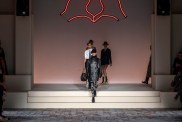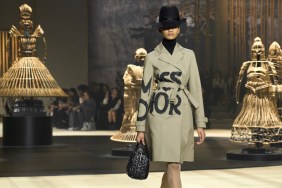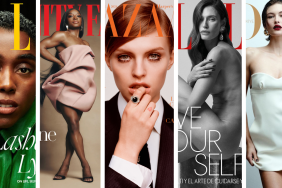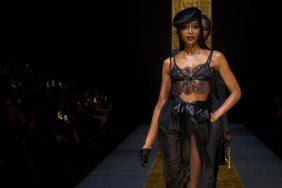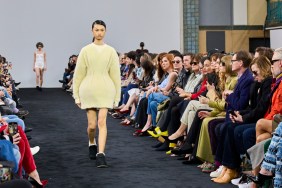Cannon: Tell us about the evolution of Haute Hippie.
Trish Wescoat Pound: When we started, it was Matt, me, my daughter Jillian who was seven at the time, and my nanny and we worked out of my apartment. Literally, Matt and I did everything. I had always worked for these big companies so I really didn’t know what an RN number was. I was president for these big companies but there was a finance department, an operations department, and a logistics department, so I remember when I first took orders and they were like you need an RN number, I was like, what’s an RN number? It was so JV.
I thought, I had been doing this for 14 years and knew everything, but I didn’t know the back of the office. So it was really tough; we would do all of the creative, we’d take every single order, go through them, ship them, allocate them, count them in the warehouse, my nanny did the color cards and steamed, and my daughter steamed…I remember in the beginning when things were real tough, I took a personal guarantee against my apartment. I had a little bit of money, a severance package of 3 months from my last job.

TWP: I had three months to figure this out. As a single mom, it was very risky but I had no choice. It was destiny.
I remember there was one night we were working and my apartment was full of rolling racks and we were dyeing clothes in the bathtub. I was talking to my accountant and didn’t realize my daughter was listening because she was faking being asleep. I was saying, “Holy s*** what did I do?” I had to figure it out. And the next day, my daughter made all these flyers and stuck them under the doors of my neighbors in the entire building. She had written, “Everything must go, $10,” but then crossed it out and put $25, some things $50 — she wanted to sell all the samples, she was so worried. She’s extremely precocious.
It’s funny, though, in some ways, the most amazing part of it was at the beginning and also the scariest part of it was at the beginning. But by far, the hardest part is now — there are now 30 people to manage!!!!!
C: Because you’re growing, you’re doubling in size every year.
TWP: We’ve been lucky, we’ve been shipping since the end of 2008. Now it’s 2012 and this is the third year we’ve been shipping. Partly because we do something different from everyone else, I think. Sometimes in bad economies… if I was to do a Theory black pant program, it might not have done well, do you know what I mean? If I had done the things I knew how to do, had been trained to do, I don’t think I would have done as well.
C: Seeing Haute Hippie for the first time in Bloomingdale’s, it was so refreshing as a stylist because I felt it was totally outside the box from what every other designer on the floor was doing. Tell us about your inspirations for your collections.
T: I didn’t think about it. Someone once said to me, “Art is somewhere between knowing and knowing what you don’t know.” I know certain things from my past experiences: blouses sell well, dresses are making a comeback, and it’s all cyclical. But I decided only to do things that I love. So I was doing a beaded dress with a chunky sweater, I showed my rep in LA and she thought I was out of my mind, but people responded.
Someone asked me who I thought I was taking market from, who’s my competition? The selling floor is like a pie, there’s only so much room, but no one is doing what I do, so there isn’t competition. I don’t know who we look like.
C: I don’t think there’s anyone at that price point ($895-$1700) that delivers what you do. That’s what’s unique about the line. It’s for a specific person who knows who they are, is unafraid to wear things, unafraid to challenge how they dress, and really goes for it.
TWP: Who would you compare us to at the designer level?
C: Maybe some elements of Stella. Parts of Galliano — but, truly hippie rocker.
TWP: Or Cavalli, the man makes sexy clothes.
When I worked for Michael Kors, he would say everyone is a member of a tribe. And I would say that I wasn’t and he would tell me I was the worst of all because I was a member of the non-tribe tribe, the most annoying.
I don’t find a way to classify myself. I’m really just a girl who works and makes clothes. I can move in all different tribes. Where he was making clothes for the Jet Set, I’m making clothes for the Gyp-Set. I was in Jamaica for New Year’s Eve, Kate Moss was there and so were other “famous” people, and everyone was RoBo — rock-bohemian. This is what I want to do better.
C: Kate is your poster child…unofficially. We all worship Kate. Tell me about how you came up with the name Haute Hippie, it’s so incredibly fitting.
TWP: I had been working on ideas for three years. Sometime in the 70s, YSL had a collection called Haute Hippie. I don’t really remember where I heard it, but I just started calling things Haute Hippie. Then I designed the double-H, which at first was barbed wire, but then it changed into what it is now and it’s so true to the clothes.
C: I loved the name of the collection “The Gypsy That I Was” — I’m a huge Stevie Nicks fan. Tell me about your musical influences.
TWP: I have certain music that I like. I like country music because I grew up in Oklahoma, but we are very much rooted in the 70s, as is the collection. There was a lot happening in the 70s, before were was tie dye. I love alternative, I like folk. But I always go back to the same people and I love Stevie Nicks. I love Jimi Hendrix, the Stones, every once in a while I’ll throw in “I Beg Your Pardon” by Lynn Anderson, “I never promised you a Rose Garden,” that was a very floral season. We name all of our prints after songs; all of our collections are autobiographical, and sometimes I want to take one back that might be about today but not tomorrow.
This is a Gypsy Operation; we literally go to India and work on a balcony. I’m best when I’m not in an office. I’ll do line sheets on a plane, visit a factory in India…everyone here travels a lot.
(continued below…)
C: There’s a great feeling of romanticism with the collection. Tell us about it.
TWP: Life should be romantique. Something happens and it’s okay to have your emotions about what’s happening; it’s okay to be sad, it’s okay to be happy. Life isn’t exactly what you think it’s going to be, but life is what you make of it and I choose to make it romantic. I feel blessed and grateful for everything that I have — not that I don’t have moments when I’m a maniac and lose sight of it all — but I can honestly say, at the end of the day, I see life as romantic. People talk about where they find inspiration, you find beauty and inspiration anywhere, it’s just how you look at it.
I believe in happily ever after, I believe in On Golden Pond, I believe in bigger causes and bigger meaning in our lives. I have learned to manage my expectations of myself and other people. I’m not perfect and I’ve learned to be okay with my imperfections.
C: I have always believed in “happily ever after” too, my parents are a test to that. What advice would you give to a young designer starting off in this down economy?
TWP: It’s interesting, you go to school and you could be incredibly talented but if you are not fortunate enough to have a family that can finance it, or find a backer, it’s very hard. So forget about the logistics of what you do, you work for someone else, you be a good person, be a person of integrity, realize that things are temporary and the bad and the good come and go. Be grounded, the more grounded you are, the better off you are.
It’s very hard for creative people to realize that. You just left school, now go find a job at a company whose clothes you really like and kill yourself and do a good job, because people remember you, they reward talent. But I think work ethic and good attitude is just as important. Have some integrity. But besides that, trust your instincts.
Try to find the right fit for yourself, learn as much as you can and surround yourself with people who have skills that you don’t have and learn as much about the business as you can so you can understand it better. You make better clothes when you know what people want to wear. That being said, once you have done your apprenticeship, trust your instincts.
If you hate the job, leave it. Life is short. I give young people a lot of opportunities because someone gave me an opportunity once or twice. Find the right fit. Also, recognize what you’re doing to not be happy. Don’t jump all over the place. Be happy, trust your instincts, take some risks, believe in yourself. Take measured risks.
C: People don’t realize that happiness isn’t easily attainable, it’s something you have to work for.
TWP: Really hard. It’s something you have to work for the rest of your life. It’s like a train: when I leave high school and don’t live with my parents, I’ll be happy. When I leave college and get a job, I’ll be happy. When I get promoted, or get married, or find a partner, or have a child, I’ll be happy, That’s BS. It’s not a train; everyone is goal-oriented but it’s the journey. Sometimes when I’m done with a collection, I never want to see it again. It’s like Tibetan sand art that takes decades to create, whole villages work on them; the minute it’s complete, they start destroying it. It’s the process.
In the beginning of the season you finish something, you’re burnt, you hate it all, and it’s never good enough. You have to do this again? So you start to look at colors, you go to London, you do a vintage trip, you put in a beading swatch, you look at fabrics…

TWP: We start with colors and prints because we have to. We do all of our own prints because it makes a difference (the guy who does our prints worked with McQueen). Sometimes I’ll look at a print and wonder why there’s a daisy or sunflower in the middle of that English rose garden? We do our prints and play with scale and color, then something happens and the color story changes from what you started off with.
Right now, we are working on “Sweet Home Alabama” and [our muse] hasn’t been home in 20 years or longer and she has to come to terms with her past and she’s having a moment that’s emotionally charged. After she leaves the Alabama trailer park, she parties in the desert somewhere doing whatever form of her indulgence is. They are sitting around a campfire in the coolest clothes. Then she takes a time out and finds herself in an English manor for a little rest, and then she’s maybe in Patagonia…it’s all about where she travels. It will be that we have gone to a place or that place in our mind; it can be a physical manifestation. I’m a global nomad.
C: I feel like there are certain pieces in your closet that define you, sometimes when you wear it it’s so you, it’s part of your personality or your aura. Describe that.
TWP: Clothes define you and mark times in your life and hold memories. When I go to a resort or Europe near the water, I take three suitcases, I lay it all out the day before and try on every outfit, I will take gowns and vintage gold belts. I take all the things that the people that go to these places, in my mind, would take. Everything is an outfit, I love long flowy georgette dresses, it’s the one thing I’ll wear color and print in. I love madras gowns and vintage jewelry. I don’t think people dress up enough. The Hoodie line is still dressed up, it’s leather jackets and gowns and vests.
C: I love the fact that you put a sweatshirt with a ball gown. I love being shown new things. Seeing something that has been shown one way and flip its perception and you give it a new life.
TWP: It’s the juxtaposition. I love a ball gown, a Halston, a Haute Hippie, but I always throw on a chunky sweater, or a tuxedo jacket. There’s nothing worse than when you go to an event and everything is predictable. That’s exactly what Haute Hippie is not, it’s a beaded dress and a pretty blouse and a vintage belt and a big bulky sweater. Or it’s a gown with a big oversize hoodie. I went to a wedding and I wore a sequined dress that was very Michelle Pfeiffer in Scarface, it was nude and open back and I wore a white tuxedo jacket and a fur throw and it was cool. It was just a little different.
I was really criticized in the beginning, it’s hard to put yourself out there. Right now, I’m doing “Sweet Home Alabama” and it’s an f-d up plaid shirt and a big floral skirt. I love it, until I don’t.
Criticize the work being done by the person at the time and not that “this is the trend and you didn’t hit it.”
C: Do you follow trends?
TWP: I’m designing for the Gyp-Set not the Jet Set, for an eclectic group. I don’t work with trends. But I do work with the big idea, that’s part of the process
C: The best designers don’t follow trends but they are their own worst critics, they pick apart their own collection more than any critic would. I feel you are the same way.
TWP: Come market opening, I have panic attacks. I’m very solution-oriented, so when I see something and it’s not what it was supposed to be, I try to work through it, change a sleeve, turn it back to front…I’m a perfectionist. I want to do a good job and be proud of what I created.
C: Tell us about Haute Hoodie?
TWP: This is a departure from Haute Hippie. We’ve been doing this all along, but now it’s a collection. I’m always looking for the hole in the market. Sunday Clothes — there is nothing in the market that is yummy; I’m a sweater girl. But it’s leather jackets and suede and it can be dressed up. The sweaters are Italian wool. They are expensive, but they are really well made. Handmade Serapes, I wear it with a gown and flats. It’s very Malibu. This feels like cashmere but it’s wool…we did henleys, they are great for guys, and long johns…with a hint of the Marlboro Man; we did a French terry blazer. On the women’s side, I love ponchos and furs. Travel knit bag with socks, and other things you need on a plane to feel comfortable on a plane.
C: I am so glad you are making men’s clothes! I just shot a few pieces on Gary Clarke Jr., a musical prodigy.
TWP: It’s about layering and is the armhole big enough to wear a leather jacket underneath? It’s about luxurious Sunday Clothes, it’s about being dressed but being comfortable.
I’m always thinking about how many layers can you wear, dress it up, dress it down. How can we do this better?
Check out: HauteHippie.com and HauteHoodie.com.
Haute Hippie
-
Haute Hippie

-
Haute Hippie

-
Haute Hippie

-
Haute Hippie

-
Haute Hoodie

-
Haute Hippie

-
Haute Hoodie

-
Haute Hippie

-
Haute Hippie

-
Haute Hippie

-
Haute Hippie



